Autumn Joys: The Ultimate Sedum Plant Guide
Updated: May 11, 2023
For easy care and spectacular beauty, try surprisingly diverse sedum plants. Discover the best ground cover sedums and sedums for borders.
Benefits of Growing Sedum Plants
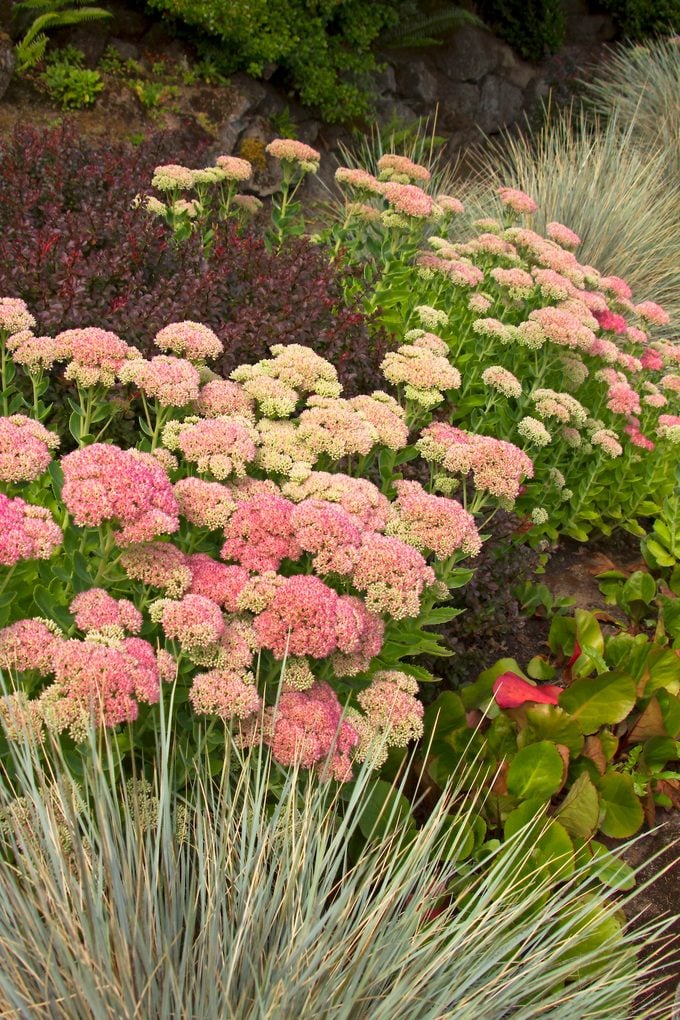
In autumn, the earthy colors of the season—russets, golds and buffs—signal that cooler temperatures are on the way. And nothing takes the stage this time of year like the classic perennial border sedum, Autumn Joy. With its garnet-hued flower heads, Autumn Joy has become something of a sedum poster child.
But it’s by no means the only worthy example of this broad family of plants. Many charming sedums offer a surprising variety of flower and foliage colors sure to capture your imagination and enhance your garden—and not just in autumn.
Plus, most sedums are just as low-maintenance as Autumn Joy, asking little more than a sunny spot in well-draining soil. Because they are technically succulents, they survive drought or neglect, thanks to their juicy, moisture-retaining leaves and tough root systems. And unlike their relatives, jade and cacti, sedums are cold-hardy in much of the country.
Read on for some of the loveliest, most easy-care and widely available choices.
Grow Autumn Fire sedum for late season color.
Sedum Plant Care Tips
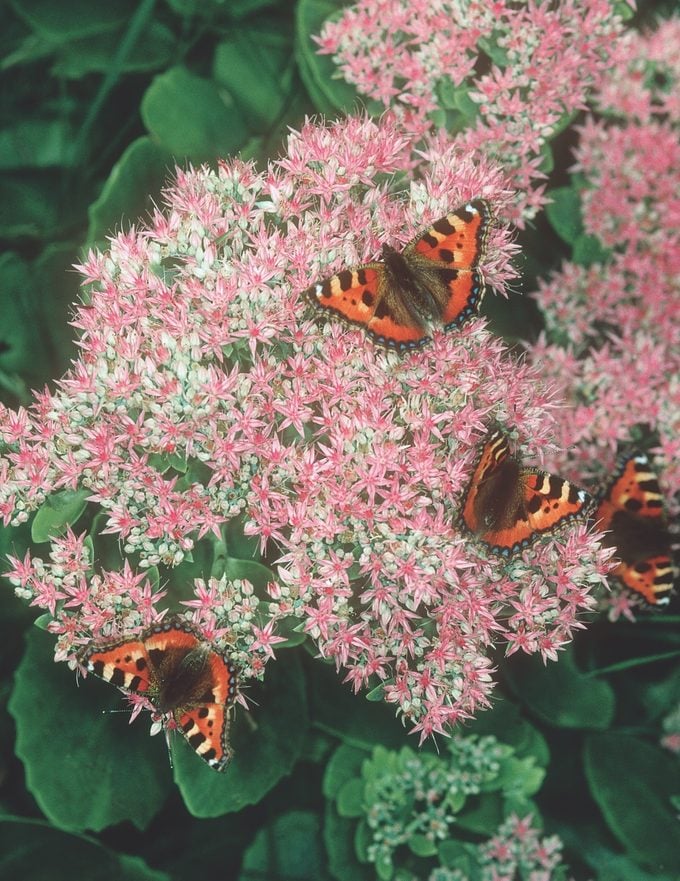
- Sun: Full sun is best, although partial shade is tolerable in hotter areas.
- Soil: Well-draining soil of average quality suits sedums.
- Water: For border sedums, maintain beauty and health with regular watering; just don’t overdo it.
- Fertilizer: Not necessary! Sedums grow robustly without a lot of fertilizer.
- Pests and diseases: These problems are mercifully rare. Aphids may gather on the leaves of young border sedums and can be evicted with a stiff spray of the hose.
- Planting time: Spring is best. In milder climates, fall planting also works. Just make sure to get your sedums in the ground before the first frost.
- Division: Divide clumps every 3 to 5 years. Otherwise, many sedums lose vigor.
Use Tall Sedums in Borders
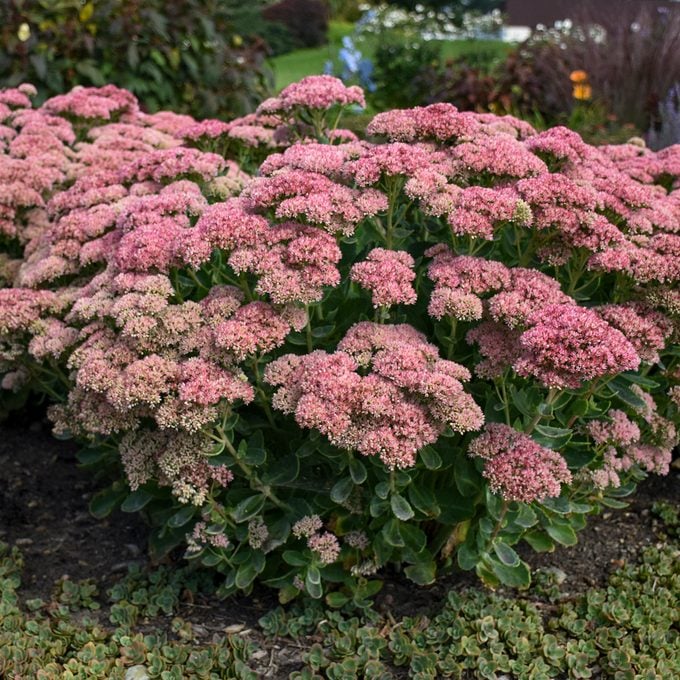
Border sedums generally fall within the 1- to 2- foot range, and Autumn Joy is the most familiar example. They grow more or less erect and have dense, domed flower heads composed of tiny starry flowers, much like a colorful broccoli head. Foliage is thick, fleshy and succulent, and runs from sage and green to smoky blue to maroon in color.
Most border sedums come to life in summer with lime-green buds that open to pink or white flowers. These tend to deepen to a dark pink or red and then segue to a rich rust or bronze as season comes to a close.
Sedums not only offer dynamic beauty from summer to fall, but they also provide a popular stage for butterflies. And if your winters are not too harsh, they will hold their ground for months longer still—their broad forms contrasting with the brown, threadbare foliage of nearby plants or perhaps gathering a cap of snow on top of their dried flowerheads.
Border Sedum Companion Plants
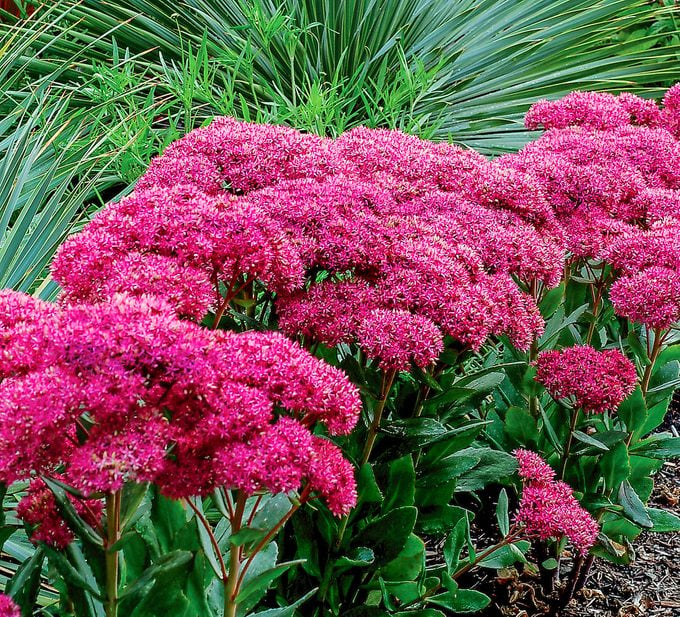
Border sedums thrive in the company of other plants because they are easy-going and nonaggressive. They look great among late-season bloomers such as asters, cultivated goldenrods and boltonias, where they contribute contrasting or harmonizing color. Gray- or silver-leaved companions, like artemisia and sage, have the advantage of complementing the changing colors of your border sedums from season to season.
Try interplanting border sedums with ornamental grasses or blade-leaved favorites like irises and daylilies (whose flowers are gone, or nearly gone, by the time sedums come into their own). With their fountains of narrow foliage, they create a nice backdrop for your statuesque sedum.
If you prefer to avoid matchmaking, cherish the colorful flowerheads by massing your border sedums. No doubt about it, a patch or ribbon of them makes a dazzling spectacle. Or experiment by adding a few new varieties to your perennial border to create a tapestrylike effect.
Gorgeous Low-Growing Sedums
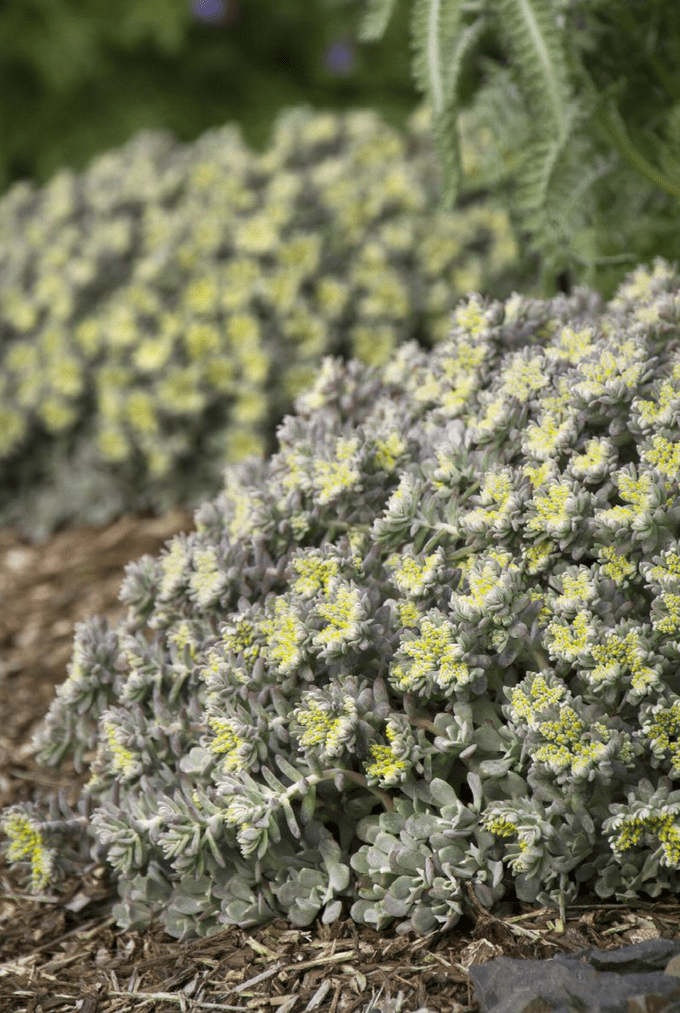
There is also a host of low-growing ground-cover sedums, or “stonecrops” as some nurseries call them. These little charmers usually remain about 4 to 6 inches high as they sprawl.
Like their bigger cousins, they have succulent leaves (which tend to be evergreen in mild climates), carry their starry flowers in clusters and thrive in average soil and sunny spots.
Because of their smaller size, ground-cover sedums are often used as botanical carpets, either on open ground or lounging over rocks and walls (note that a massed, lush look takes a few seasons to develop). Alas, they are generally not tough enough to withstand foot traffic.
Individual plants, particularly those with striking foliage or flowers, are terrific for rock gardens, although you sometimes have to curtail their wandering ways by yanking out a few.
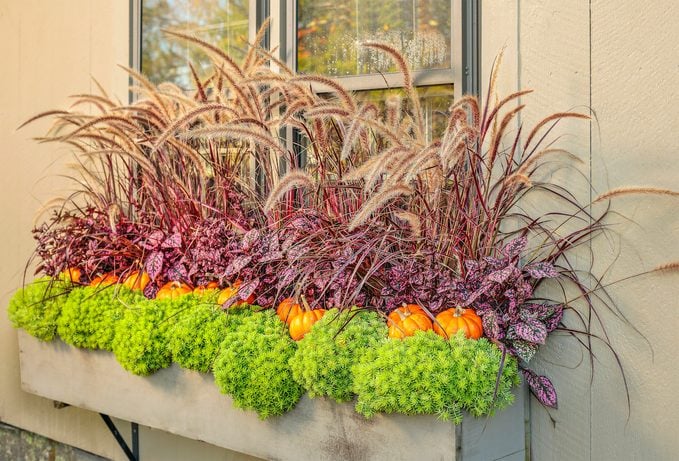
These sedums can also soften the edges of formal displays in urn-type planters or trough gardens. Solo, they’ll thrive in shallow pots filled with gritty soil.
Many gardeners prefer these ground covers by themselves or paired with one another. I know an adventurous gardener who scooped up flats full of low-lying sedums on sale at the end of the summer, planted them on an embankment, and has relished their handsome foliage and jewel-like color combinations ever since.
The related succulents, hens-and-chicks (Sempervirens), thrive in the same settings and are popular bedfellows. Their slightly larger scale and bold, star-shaped flower clusters make for dramatic contrasts. No matter how you employ them, you’ll appreciate how easy-going and dependably attractive these plants are.
Best Sedums for Borders
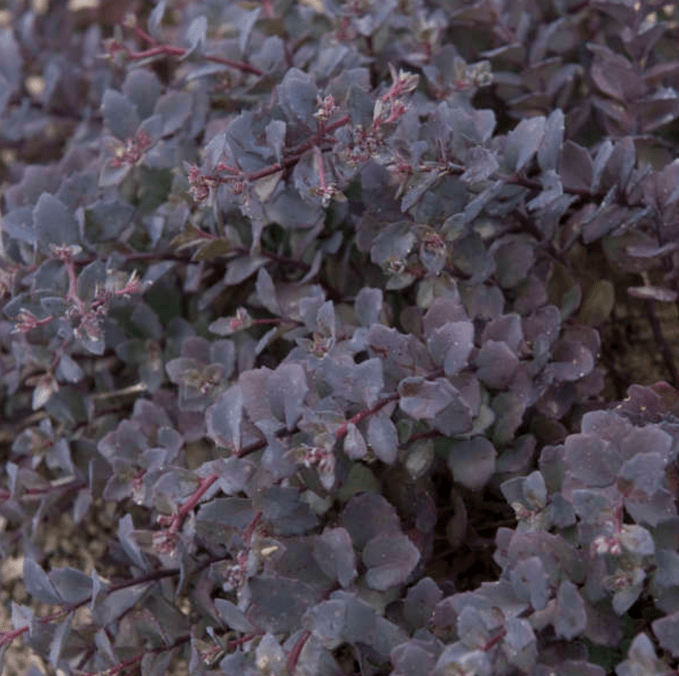
- Brilliant (Hylotelephium spectabile ‘Brilliant’) reaches up to 1-1/2 feet high. Its large flower heads are bright mauve-pink.
- Matrona (Hylotelephium telephium ‘Matrona’) has sage-green to gray foliage with hints of lavender, edged pink. Its flowers are smoky pink.
- Meteor (Hylotelephium spectabile ‘Meteor’) is very similar to Brilliant, but its rich pink-purple flowers are even more vivid.
- Ruby Glow (Hylotelephium ‘Ruby Glow’) boasts ruddy stems, ruby red flower heads and green leaves edged or tinged with dusky purple or red; it’s often under a foot in height.
- Stardust (Hylotelephium spectabile ‘Stardust’) has nearly white flowers and blue-green leaves.
- Sunset Cloud (Hylotelephium ‘Sunset Cloud’) sports chalky blue leaves; the flower heads are a rich, rosy red. It’s somewhat shorter than other border sedums.
- Vera Jameson (Hylotelephium ‘Vera Jameson’) has soft, waxy blue foliage that later turns purple-maroon or even bronze, and magenta flower heads—a gorgeous contrast. It is often less than a foot tall.
Best Sedums for Ground Covers
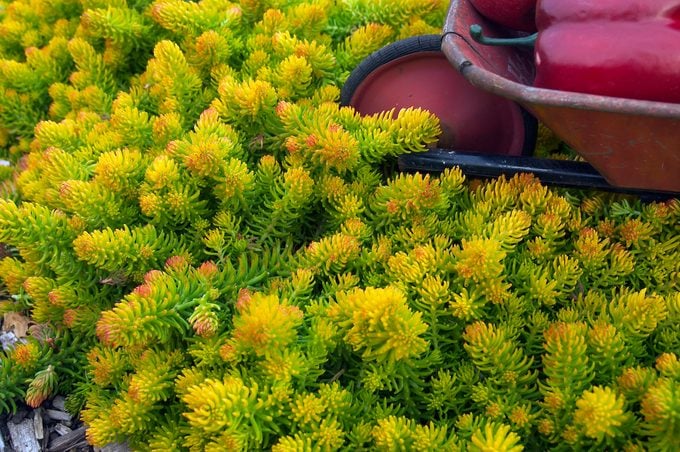
- Coral Carpet (Hylotelephium album ‘Coral Carpet’) sports tiny leaves that turn from a vibrant green to a reddish-bronze in winter; star-shaped white flowers appear above foliage.
- Russian stonecrop (Hylotelephium kamtschaticum) forms a dense mat of green leaves, vaguely resembling a tiny succulent version of pachysandra. The cultivar Variegatum has whiterimmed leaves.
- Christmas Cheer (Hylotelephium x rubrotinctum) stands under 6 inches, with yellow flowers and chubby red and green leaves. Hardy only in Zones 9 and 10, its red coloring becomes more pronounced in more light or colder weather, hence the name.
- Angelina stonecrop (Hylotelephium rupestre ‘Angelina’) is an aggressive spreader. It has bright yellow flowers and chartreuse foliage that often turns amber in the fall.
- Cape Blanco (Hylotelephium spathuliofolium ‘Cape Blanco’) features powdergray leaves, pink stems, and yellow flowers.
- Dragon’s Blood Two-Row Stonecrop (Hylotelephium spurium ‘Dragon’s Blood’) is dramatic, with its greenish bronze to darker red foliage and burgundy flowers.